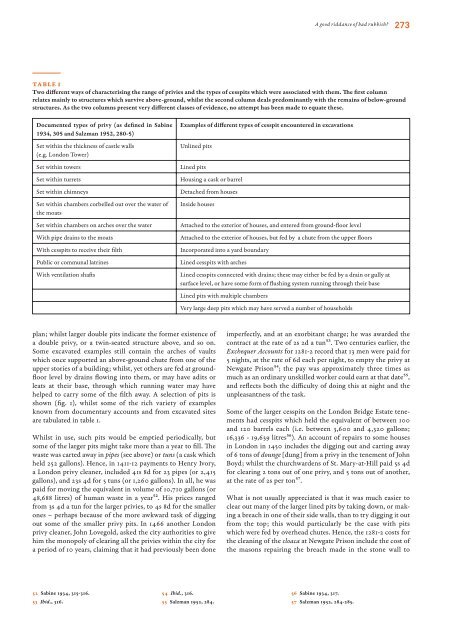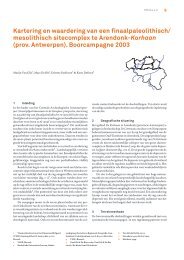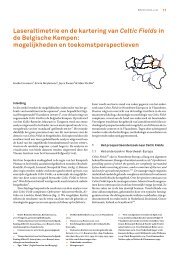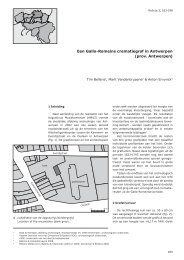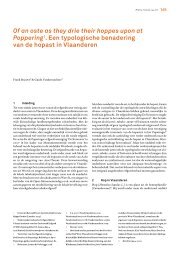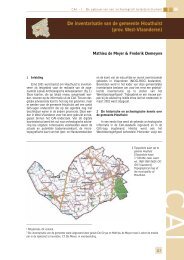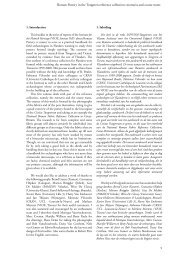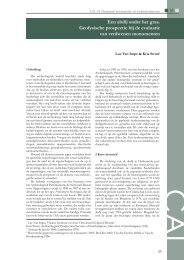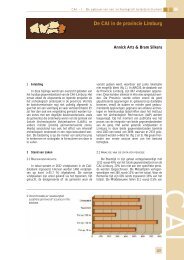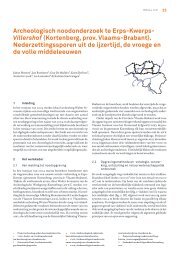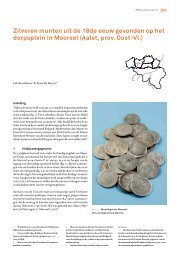Exchanging Medieval Material Culture Studies on archaeology and ...
Exchanging Medieval Material Culture Studies on archaeology and ...
Exchanging Medieval Material Culture Studies on archaeology and ...
Create successful ePaper yourself
Turn your PDF publications into a flip-book with our unique Google optimized e-Paper software.
52 Sabine 1934, 315-316.<br />
53 Ibid., 316.<br />
54 Ibid., 316.<br />
55 Salzman 1952, 284.<br />
A good riddance of bad rubbish? 273<br />
Table 1<br />
Two diff erent ways of characterising the range of privies <strong>and</strong> the types of cesspits which were associated with them. Th e fi rst column<br />
relates mainly to structures which survive above-ground, whilst the sec<strong>on</strong>d column deals predominantly with the remains of below-ground<br />
structures. As the two columns present very diff erent classes of evidence, no attempt has been made to equate these.<br />
Documented types of privy (as defi ned in Sabine<br />
1934, 305 <strong>and</strong> Salzman 1952, 280-5)<br />
Set within the thickness of castle walls<br />
(e.g. L<strong>on</strong>d<strong>on</strong> Tower)<br />
plan; whilst larger double pits indicate the former existence of<br />
a double privy, or a twin-seated structure above, <strong>and</strong> so <strong>on</strong>.<br />
Some excavated examples still c<strong>on</strong>tain the arches of vaults<br />
which <strong>on</strong>ce supported an above-ground chute from <strong>on</strong>e of the<br />
upper stories of a building; whilst, yet others are fed at groundfl<br />
oor level by drains fl owing into them, or may have adits or<br />
leats at their base, through which running water may have<br />
helped to carry some of the fi lth away. A selecti<strong>on</strong> of pits is<br />
shown (fi g. 1), whilst some of the rich variety of examples<br />
known from documentary accounts <strong>and</strong> from excavated sites<br />
are tabulated in table 1.<br />
Whilst in use, such pits would be emptied periodically, but<br />
some of the larger pits might take more than a year to fi ll. Th e<br />
waste was carted away in pipes (see above) or tuns (a cask which<br />
held 252 gall<strong>on</strong>s). Hence, in 1411-12 payments to Henry Ivory,<br />
a L<strong>on</strong>d<strong>on</strong> privy cleaner, included 41s 8d for 23 pipes (or 2,415<br />
gall<strong>on</strong>s), <strong>and</strong> 23s 4d for 5 tuns (or 1,260 gall<strong>on</strong>s). In all, he was<br />
paid for moving the equivalent in volume of 10,710 gall<strong>on</strong>s (or<br />
48,688 litres) of human waste in a year52. His prices ranged<br />
from 3s 4d a tun for the larger privies, to 4s 8d for the smaller<br />
<strong>on</strong>es – perhaps because of the more awkward task of digging<br />
out some of the smaller privy pits. In 1466 another L<strong>on</strong>d<strong>on</strong><br />
privy cleaner, John Lovegold, asked the city authorities to give<br />
him the m<strong>on</strong>opoly of clearing all the privies within the city for<br />
a period of 10 years, claiming that it had previously been d<strong>on</strong>e<br />
Examples of diff erent types of cesspit encountered in excavati<strong>on</strong>s<br />
Unlined pits<br />
Set within towers Lined pits<br />
Set within turrets Housing a cask or barrel<br />
Set within chimneys Detached from houses<br />
Set within chambers corbelled out over the water of<br />
the moats<br />
Inside houses<br />
Set within chambers <strong>on</strong> arches over the water Attached to the exterior of houses, <strong>and</strong> entered from ground-fl oor level<br />
With pipe drains to the moats Attached to the exterior of houses, but fed by a chute from the upper fl oors<br />
With cesspits to receive their fi lth Incorporated into a yard boundary<br />
Public or communal latrines Lined cesspits with arches<br />
With ventilati<strong>on</strong> shaft s Lined cesspits c<strong>on</strong>nected with drains; these may either be fed by a drain or gully at<br />
surface level, or have some form of fl ushing system running through their base<br />
Lined pits with multiple chambers<br />
Very large deep pits which may have served a number of households<br />
imperfectly, <strong>and</strong> at an exorbitant charge; he was awarded the<br />
c<strong>on</strong>tract at the rate of 2s 2d a tun53. Two centuries earlier, the<br />
Exchequer Accounts for 1281-2 record that 13 men were paid for<br />
5 nights, at the rate of 6d each per night, to empty the privy at<br />
Newgate Pris<strong>on</strong>54; the pay was approximately three times as<br />
much as an ordinary unskilled worker could earn at that date55,<br />
<strong>and</strong> refl ects both the diffi culty of doing this at night <strong>and</strong> the<br />
unpleasantness of the task.<br />
Some of the larger cesspits <strong>on</strong> the L<strong>on</strong>d<strong>on</strong> Bridge Estate tenements<br />
had cesspits which held the equivalent of between 100<br />
<strong>and</strong> 120 barrels each (i.e. between 3,600 <strong>and</strong> 4,320 gall<strong>on</strong>s;<br />
16,336 - 19,639 litres56). An account of repairs to some houses<br />
in L<strong>on</strong>d<strong>on</strong> in 1450 includes the digging out <strong>and</strong> carting away<br />
of 6 t<strong>on</strong>s of dounge [dung] from a privy in the tenement of John<br />
Boyd; whilst the churchwardens of St. Mary-at-Hill paid 5s 4d<br />
for clearing 2 t<strong>on</strong>s out of <strong>on</strong>e privy, <strong>and</strong> 5 t<strong>on</strong>s out of another,<br />
at the rate of 2s per t<strong>on</strong>57.<br />
What is not usually appreciated is that it was much easier to<br />
clear out many of the larger lined pits by taking down, or making<br />
a breach in <strong>on</strong>e of their side walls, than to try digging it out<br />
from the top; this would particularly be the case with pits<br />
which were fed by overhead chutes. Hence, the 1281-2 costs for<br />
the cleaning of the cloaca at Newgate Pris<strong>on</strong> include the cost of<br />
the mas<strong>on</strong>s repairing the breach made in the st<strong>on</strong>e wall to<br />
56 Sabine 1934, 317.<br />
57 Salzman 1952, 284-285.


